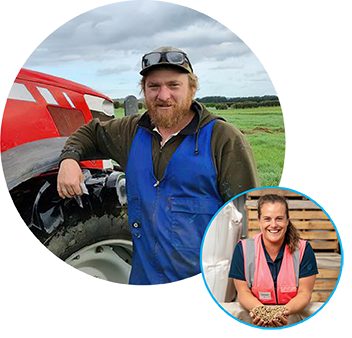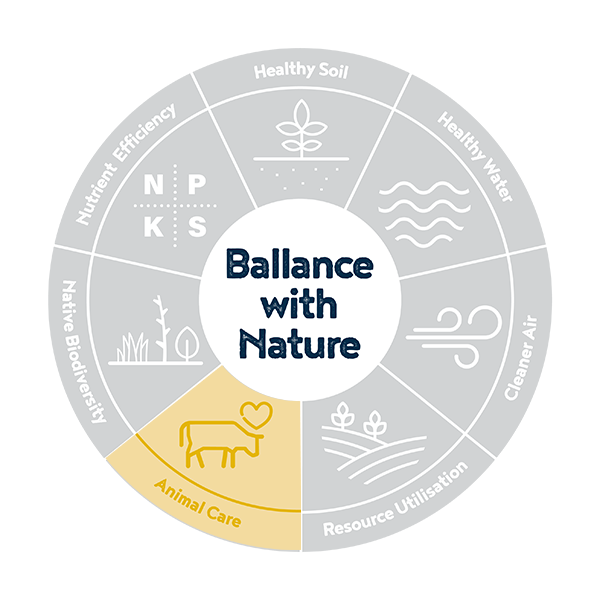
Sam Ebbett is a sharemilker with Mark and Jacqui Muller in Eltham, South Taranaki. He chats to SealesWinslow Nutrition and Quality Manager Natalie Hughes about the importance of transition feeding for their herd of 530 dairy cows.
What are detainment bunds and how can they help improve water quality?
“Animal care is really at the core of what we do. To get maximum value out of our cows, we’ve got to give them maximum care. I like to think of them as professional athletes – we’ve got a herd of All Blacks here, so we can’t treat them like average Joes! They’ve got to have the best nutrition. I’m also a big fan of good stockmanship. If the cows come up to you when you go into the paddock, you can take a bit of pride in that.”
So you’ve got elite athletes. How do you set them up for a successful season?
“Transition feeding is a really big part of looking after our cows, and it makes a huge difference to the health of our herd. What you do in those 21 days before calving can dictate what your cows do for the rest of the year.”
How do you plan for a successful transition?
“For us there are three crucial times. The first is in May when we’re winding the herd down, trying to minimise protein intake, to reduce milk. This helps the cows naturally take their feet off the gas when it comes to milk production. The second is over the dry season when I’m really focused on maintaining their body condition. This makes winter easier to manage without the added hassle of trying to put on weight. The third is around calving time, dividing out when cows are due to calve. When they move into their springer mob, that’s when the focus goes on ensuring all their minerals are supplemented.”
So what are you feeding them during the transition?
“In those 21 days before calving, we’ll be feeding 60% hay, 40% grass. That’s because the potassium in the grass can affect how cows can mobilise calcium when they calve. We try to offset that by avoiding effluent paddocks and using supplements to dilute the amount of potassium in the diet. We’re really focussed on boosting the magnesium intake, so when she does calf, she can hit the ground running with no health issues.”
That’s great, and as you’ve pointed out, what you do in that transition period can have a huge impact on the health of your herd for the whole year. What’s made the biggest difference for you?
“Well, we’d had a few problems with milk fever in the past, and working together with the farm owners, we worked out that our cows needed extra magnesium. For a lot of farmers, magnesium delivery can be as simple as adding minerals straight into their water troughs or dusting it onto paddocks. But our challenge is, being under the mountain, we get over 2 metres of rain, so the cows just find other places to drink. Best practise is using two different delivery methods of magnesium. We drench hay bales with mag, and this season was the first time we tried mineral lick blocks. It beats dusting paddocks and I was sick of getting dust all over my hands! We’ve had way less trouble with milk fever since trialling the lick blocks, so it’s working really well for us. But it’s different for every farm system, and there’s no one way to do anything.”
How did you learn about transition feeding?
"It’s been mostly trial and error and being able to see the numbers! If you get to the end of the season and see you’re 10K short of solids, that’s when you go back and see what you can do differently next time. When you’re at 88-90% success, you’re just trying to adjust little things to get closer to 100%. Even a one or two percent improvement can make a difference. So we’re trialling things all the time.”
What would you say to other farmers who are considering new ways to transition feed?
“A lot of farmers are scared of change. It’s all well and good being in our own little world in Taranaki, but there’s a big world out there, and listening to what others are doing can be really helpful. So I’d say don’t be afraid to ask for advice – not just about what other farmers have done, but also why they’ve done it. Then put a really solid plan in place.”
What excites you about the future of farming in New Zealand?
“The future is relatively uncertain – the rules are changing – but where there’s change there’s opportunity. Regulations can be scary but I think the future’s bright. There’s money to be made and you just have to find it. You just have to stay open to new ideas.”
Download the full PDF here





